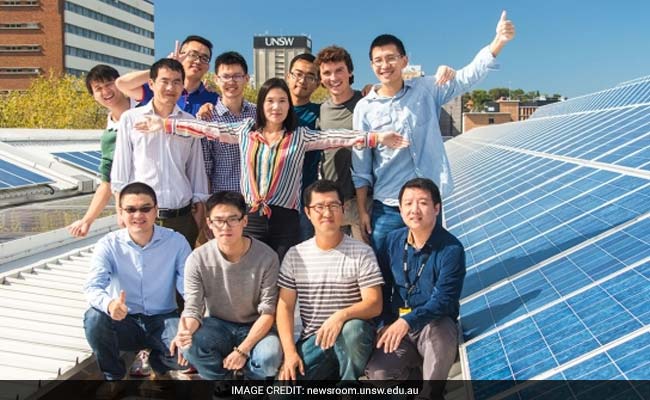
Dr Xiaojing Hao of UNSW's Australian Centre for Advanced Photovoltaics holding the new CZTS solar cells.
- 'Zero-energy' buildings generate as much power as they consume
- New high-efficiency, low-toxicity solar cells promise to change the game
- They can generate electricity from sunlight that strikes tiles & windows
Did our AI summary help?
Let us know.
Melbourne, Australia:
'Zero-energy' buildings - which generate as much power as they consume - are now closer to reality, as scientists have achieved the world's highest efficiency using flexible solar cells that are non-toxic and cheaper to make.
Until now, the promise of 'zero-energy' buildings been held back by two hurdles: the cost of the thin-film solar cells (used in facades, roofs and windows), and the fact they are made from scarce, and highly toxic, materials.
Researchers at the University of New South Wales in Australia achieved the world's highest efficiency rating for a full-sized thin-film solar cell using a competing thin-film technology, known as CZTS.
 The US National Renewable Energy Laboratory (NREL) has confirmed this world leading 7.6 per cent efficiency in a one square centimetre area CZTS cell.
The US National Renewable Energy Laboratory (NREL) has confirmed this world leading 7.6 per cent efficiency in a one square centimetre area CZTS cell.
Unlike its thin-film competitors, CZTS cells are made from abundant materials, such as copper, zinc, tin and sulphur.
CZTS has none of the toxicity problems of its two thin-film rivals, known as CdTe (cadmium-telluride) and CIGS (copper-indium-gallium-selenide).
Cadmium and selenium are toxic at even tiny doses, while tellurium and indium are extremely rare.
"This is the first step on CZTS's road to beyond 20 per cent efficiency, and marks a milestone in its journey from the lab to commercial product," said Xiaojing Hao, from UNSW.
"In addition to its elements being more commonplace and environmentally benign, we're interested in these higher bandgap CZTS cells for two reasons," said Martin Green, professor at UNSW.
"They can be deposited directly onto materials as thin layers that are 50 times thinner than a human hair, so there's no need to manufacture silicon 'wafer' cells and interconnect them separately," Green said.
 "They also respond better than silicon to blue wavelengths of light, and can be stacked as a thin-film on top of silicon cells to ultimately improve the overall performance," he said.
"They also respond better than silicon to blue wavelengths of light, and can be stacked as a thin-film on top of silicon cells to ultimately improve the overall performance," he said.
By being able to deposit CZTS solar cells on various surfaces, researchers believe this puts them firmly on the road to making thin-film photovoltaic cells that can be rigid or flexible, and durable and cheap enough to be widely integrated into buildings to generate electricity from the sunlight that strikes structures such as glazing, facades, roof tiles and windows.
Currently, thin-film photovoltaic cells like CdTe are used mainly in large solar power farms, as the cadmium toxicity makes them unsuitable for residential systems, while CIGS cells are more commonly used in Japan on rooftops. Until now, most architects have used conventional solar panels made from crystalline silicon.
While these are even cheaper than CZTS cells, they do not offer the same flexibility for curved surfaces and other awkward geometries needed to easily integrate into building designs.
Until now, the promise of 'zero-energy' buildings been held back by two hurdles: the cost of the thin-film solar cells (used in facades, roofs and windows), and the fact they are made from scarce, and highly toxic, materials.
Researchers at the University of New South Wales in Australia achieved the world's highest efficiency rating for a full-sized thin-film solar cell using a competing thin-film technology, known as CZTS.

The new high-efficiency, low-toxicity solar cells developed by UNSW's Australian Centre for Advanced Photovoltaics.
Unlike its thin-film competitors, CZTS cells are made from abundant materials, such as copper, zinc, tin and sulphur.
CZTS has none of the toxicity problems of its two thin-film rivals, known as CdTe (cadmium-telluride) and CIGS (copper-indium-gallium-selenide).
Cadmium and selenium are toxic at even tiny doses, while tellurium and indium are extremely rare.
"This is the first step on CZTS's road to beyond 20 per cent efficiency, and marks a milestone in its journey from the lab to commercial product," said Xiaojing Hao, from UNSW.
"In addition to its elements being more commonplace and environmentally benign, we're interested in these higher bandgap CZTS cells for two reasons," said Martin Green, professor at UNSW.
"They can be deposited directly onto materials as thin layers that are 50 times thinner than a human hair, so there's no need to manufacture silicon 'wafer' cells and interconnect them separately," Green said.

Dr Xiaojing Hao (centre) and her CZTS Solar Cell Group at the UNSW School of Photovoltaic and Renewable Energy Engineering.
By being able to deposit CZTS solar cells on various surfaces, researchers believe this puts them firmly on the road to making thin-film photovoltaic cells that can be rigid or flexible, and durable and cheap enough to be widely integrated into buildings to generate electricity from the sunlight that strikes structures such as glazing, facades, roof tiles and windows.
Currently, thin-film photovoltaic cells like CdTe are used mainly in large solar power farms, as the cadmium toxicity makes them unsuitable for residential systems, while CIGS cells are more commonly used in Japan on rooftops. Until now, most architects have used conventional solar panels made from crystalline silicon.
While these are even cheaper than CZTS cells, they do not offer the same flexibility for curved surfaces and other awkward geometries needed to easily integrate into building designs.
Track Latest News Live on NDTV.com and get news updates from India and around the world

